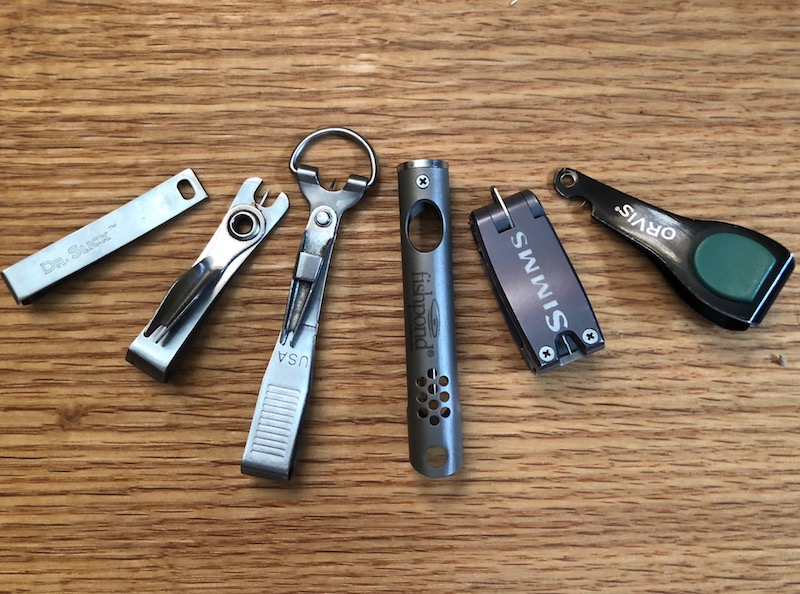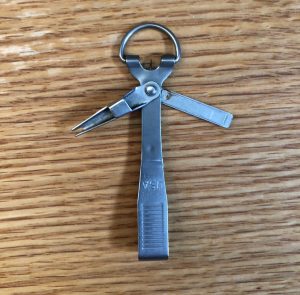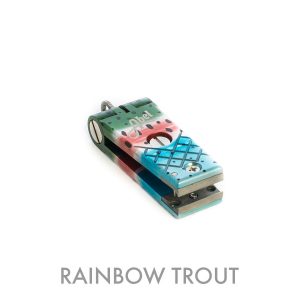
It’s Time to Quit Using Your Teeth….
Welcome to the wonderful world of nippers! It’s probably pretty easy to figure out that the primary function of nippers (aka clippers, cutters, snips, etc.) is to cut your line. They are mostly used to trim the tag ends of monofilament after tying a knot or to cut a new piece of tippet from a spool. But as you’ll see, the right pair of nippers can perform a number of other tasks as well.
As I have described before, my beginnings in this sport were humble at best and my funds were rather limited. There was a lot I could do with $10 back then and I certainly didn’t want to waste it on nippers – not when I could just use fingernail clippers. That strategy served me well for a time, until I figured out what a lot of fishermen eventually figure out. First, fingernail clippers are made of very cheap, soft metal, and after repeatedly clipping monofilament line, they begin forming a series of nicks in the blade. It’s not long before they become completely useless. Second, when regularly exposed to water (such as every time you go fishing), they rust – quickly.
So you can constantly replace in expensive fingernail clippers or you can do what I ultimately did – drop $10 on a decent pair of nippers. They’re rustproof and will last years before the blades begin wearing out. The other benefit to a good pair of nippers is they are designed to cut line, not fingernails. What does that mean?
When working with smaller trout flies, particularly dry flies, it can be difficult to prevent the large, curved head of generic fingernail clippers from also clipping away some of the hackle. The straight, somewhat recessed blades on fly fishing nippers are designed work and cut in tight spaces. Most nippers designed for fly fishing also include another simple but highly useful feature – a small needle.
When a fly tyer finishes a fly, thread is knotted near the hook eye and coated with a thin, invisible cement. Well, in the world of fly tying, time is money and production fly tyers apply that cement quickly, often leaving an invisible layer in the hook eye. When it comes time for you to tie that fly on your line, you can’t get the tippet through the hook eye because it’s coated in glue. This happens even more frequently with hard-bodied poppers that might be dipped in paint, only it’s the paint that is coating the hook eye. The little needle on your
nippers is designed to clear that layer of cement or paint and preserve your sanity when attempting to attach a fly.
 As with most any fly fishing product these days, there are seemingly endless nipper styles and features to suit your needs and tastes. Some are just shaped differently, boasting a better ergonomic design. Others are equipped with additional tools for tasks such as tying knots or sharpening hooks. And if you want to take it to the next level, check out this description of Abel’s nippers:
As with most any fly fishing product these days, there are seemingly endless nipper styles and features to suit your needs and tastes. Some are just shaped differently, boasting a better ergonomic design. Others are equipped with additional tools for tasks such as tying knots or sharpening hooks. And if you want to take it to the next level, check out this description of Abel’s nippers:
- Designed, manufactured and assembled in the USA
- Anodized 6061-T6 aluminum body construction
- Replaceable jaws – machined out of premium grade Crucible CPM S35VN stainlesssteel, then heat treated to 58-60rc
- Engineered to cut 7X – 100 lb mono and braid
- Two Year limited warranty on the jaws after initial purchase
- Pin – 316 stainless steel
 And they can be yours in black for a mere $85. For custom colors, they’re just $105. And with a cool fish print… a steal at $165. Yep, $165 for line cutters. All of a sudden, $10 for a pair of nippers doesn’t sound too bad, does it? As with anything else, if you have the disposable income and want to spend $165 of it on nippers, go ahead. I won’t judge you.
And they can be yours in black for a mere $85. For custom colors, they’re just $105. And with a cool fish print… a steal at $165. Yep, $165 for line cutters. All of a sudden, $10 for a pair of nippers doesn’t sound too bad, does it? As with anything else, if you have the disposable income and want to spend $165 of it on nippers, go ahead. I won’t judge you.
